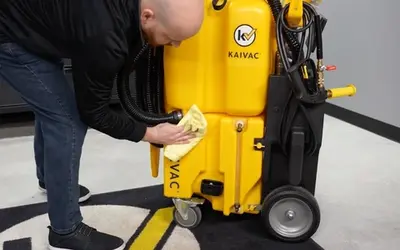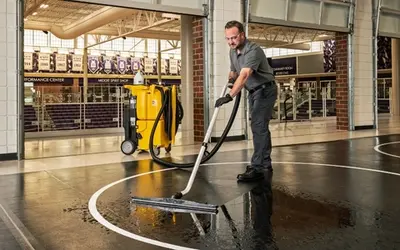Elementary School Cleaning: How to Make Your School Sparkle

Elementary school cleaning is a challenge. The buildings contain different hard and soft surfaces, lots of restrooms, tons of touchpoints and plenty of little kids coughing, sneezing, spilling and tracking in dirt, grit and microbes. As a result, elementary schools are often called the germiest buildings in America.
Getting the clean wrong in these spaces can have dire consequences including increased absenteeism, reduced moral and lagging productivity. There are as many as 22 million school days lost to the common cold each year, while 38 million are lost to influenza. Elementary students are especially susceptible as they contract between eight to 10 colds or the flu each year. This high level of absenteeism can lead to a higher number of dropouts.
Yet budget shortfalls often force districts to cut cleaning personnel. How can school districts maintain their facilities and the bottom line? Find solutions and techniques for elementary school cleaning that can meet both objectives.
Floor Maintenance: The Challenge of Hard and Soft Surfaces
Elementary schools have lots of hard surface floors; think hallways, lobbies, gymnasiums, cafeteria and individual classrooms. Vinyl composite tile (VCT) is a popular flooring choice for all of these areas as it’s affordable, durable and stylish. It also stands up well to heavy rolling loads and is relatively easy to maintain.
But VCT isn’t the only material underfoot. Other flooring choices include Luxury Vinyl Tile, terrazzo, and even hardwood for the gymnasium. Some schools may choose carpet or carpet tile for select areas like libraries or reading nooks.
‘In elementary schools, especially, kids like to sit on the floor. Other areas, such as art rooms, science labs, mass circulation areas and eating spaces — places that are susceptible to moisture, food spills or other contaminants — might be better suited for hard floors.’ Explains Tom Bates, managing principal of BLRB Architects in Tacoma, WA in an article published in American School & University.
This mix of materials can complicate maintenance protocols but only slightly.
Carpet should be vacuumed daily. Blot spills up immediately to prevent stains and mold growth. For hard surfaces many schools rely on autoscrubbers. Not only is this technology expensive and hard-to-use, these machines require floors be dust mopped first to avoid scratching the finish, making them less efficient.
In response some schools are switching to Kaivac’s AutoVac. ‘OmniFlex machines are typically $4,000 less than the traditional auto scrubber and do a comparable job. They are also great for applying gym floor finish using a T-Bar method, dispensing floor stripper and using as a wet/dry vacuum,’ explains Michael Ward, Custodial Coordinator and Trainer.
School Restroom Maintenance: Combating Soils, Microbes and ‘That Smell’
Maintaining the restrooms may be the most important cleaning job in an elementary school. After all, no one wants to use a dirty facility and for good reason. Pathogenic microorganisms, blood and other bodily fluids can often be found on surfaces and touchpoints. Slip, trip and fall accidents are more common in poorly maintained restrooms. And offensive odors make the space even more unpleasant.
But most importantly, badly maintained restrooms send the demoralizing message that students, faculty and staff are just not significant or valuable.
That demoralization spreads to the cleaning staff who may be doing the best job they can with the tools they have. Unfortunately, mops, rags and buckets are inefficient by design. Using them requires workers to bend, twist and get on their hands and knees. Even worse, all that work doesn’t fully remove soils or that offensive smell.
Kaivac’s No-Touch Cleaning systems offer a better choice. The systems apply fresh cleaning solution to all restroom surfaces including:
- Floors
- Counters
- Fixtures like toilets, urinals and sinks
- Doors
- Tile and grout surfaces.
After waiting an appropriate dwell time, the surfaces are power rinsed with fresh water. Then a built-in wet/vac system vacuums the liquids up. They’re sixty times more effective at removing contaminates at one third of the time. And because they remove pathogens from porous grout, they eliminate offensive smells.
Touchpoint Maintenance: Cleaning Desks, Drinking Fountains and Everything Else
Cleaning floors and restrooms are a big part of a janitor’s job, but don’t forget all those other dirty surfaces. A study by Kelly R. Bright, PhD, Stephanie A. Boone, MPH, PhD, and Charles P. Gerba, PhD found that frequently used surfaces like water fountain toggles, pencil sharpeners, keyboards and faucet handles were the most contaminated with bacteria while desktops, faucet handles and paper towel dispensers were most contaminated with viruses.
Old fashioned cleaning technology like rags can’t fully remove these pathogens. They also introduce the chance of cross contamination.
Kaivac has developed a contact point cleaning system that cleans and disinfects flat surfaces very well. The KaiFly system allows workers to rapidly remove soils and pathogens from desktops, table tops and more. The system works in about half the time, increasing productivity and maintains the same effectiveness from the first surface cleaned to the last.
For fountain toggles, keyboards, faucet handles and all the other irregularly-shaped touchpoints, try KaiWipes. Packed dry, these disposable towels can be paired with your diluted cleaning solution be it a Green Cleaning option, EPA-registered disinfectant or anything in-between. (NOTE: When using an EPA-registered disinfectant, the EPA-registered disinfectant must have label directions for applying the product with a cloth. When using such an EPA-registered disinfectant, you must follow the directions for use.)
Elementary School Maintenance: The Summer Edition
Summer and spring break are a great time to deep clean areas and refinish floors. But be aware. ‘..year-round schools, wrap-around programs and the growth of recreation programs…makes it much more difficult to plan large maintenance projects,’ according to Jerry Enderle, editor of School Planning & Management Magazine.
Still, break time is the best time to take stock of each room, assess its needs and make the repairs and upgrades that would be too disruptive when the building is completely full. It’s also a good time to assess your equipment and protocols.
Want more great elementary school cleaning ideas? Explore our K-12 Education page and related cleaning solutions.
Related Posts

Preventive Maintenance for Your No-Touch Cleaning® System
Your Kaivac No-Touch Cleaning system makes restroom maintenance fast and easy. Keeping your No-Touch Cleaning system in good working order is also fast and easy. Kaivac makes performing preventative maintenance and troubleshooting potential issues simple. No special equipment or technical expertise required.
Read more
A Cleaning Lesson from Schools and Universities that Rely on Kaivac Systems
School, college, and university facilities departments from around the country love their Kaivac Cleaning Systems. Why wouldn’t they? Designed with the custodial worker in mind, these tools and processes from Kaivac are easy to master, work super-fast, and deliver exceptionally clean, fresh-smelling spaces.
Read more
Reduce Absenteeism Through Better School Cleaning
K-12 school leaders are coming up with a variety of ways to combat chronic absenteeism. Strategies like offering in-school laundry services and basic health care show a lot of promise. But providing better cleaning may be one of the most effective, most cost-efficient tactics available.
Read more